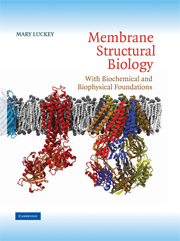Book contents
- Frontmatter
- Contents
- Preface
- 1 Introduction
- 2 The Diversity of Membrane Lipids
- 3 Tools for Studying Membrane Components: Detergents and Model Systems
- 4 Proteins in or at the Bilayer
- 5 Bundles and Barrels
- 6 Functions and Families
- 7 Protein Folding and Biogenesis
- 8 Diffraction and Simulation
- 9 Membrane Enzymes and Transducers
- 10 Transporters and Channels
- 11 Membrane Protein Assemblies
- 12 Themes and Future Directions
- Appendix I Abbreviations
- Appendix II Single-Letter Codes for Amino Acids
- Index
- References
4 - Proteins in or at the Bilayer
- Frontmatter
- Contents
- Preface
- 1 Introduction
- 2 The Diversity of Membrane Lipids
- 3 Tools for Studying Membrane Components: Detergents and Model Systems
- 4 Proteins in or at the Bilayer
- 5 Bundles and Barrels
- 6 Functions and Families
- 7 Protein Folding and Biogenesis
- 8 Diffraction and Simulation
- 9 Membrane Enzymes and Transducers
- 10 Transporters and Channels
- 11 Membrane Protein Assemblies
- 12 Themes and Future Directions
- Appendix I Abbreviations
- Appendix II Single-Letter Codes for Amino Acids
- Index
- References
Summary
The chemical and physical properties of the lipids described in Chapter 2 make it clear that the lipid bilayer provides a special milieu for proteins. Its constraints affect the structure, function, and regulation of proteins that dock on it or assemble in it to perform jobs such as energy transduction, nutrient transport, and signaling. The variety among proteins that interact in some way with the membrane is quite astonishing and provides fascinating examples of how these proteins are structured to work in their environment.
This chapter first defines the classes of proteins that are found in or at the bilayer. It describes many examples of peripheral proteins, as well as some lipid-anchored proteins, before looking at what modulates the interactions of these proteins with membrane lipids. Next it focuses on molecules that insert into the membrane, including examples of toxins, colicins, and ion-carrying peptides. Then a look at the special qualities of the nonpolar milieu of the membrane explains many characteristics of integral membrane proteins. The chapter ends with studies of protein–lipid interactions in membranes.
CLASSES OF PROTEINS THAT INTERACT WITH THE MEMBRANE
A typical biomembrane contains many species of proteins, some embedded in the lipid bilayer and others on its surface. The Fluid Mosaic Model described in Chapter 1 distinguished between extrinsic and intrinsic membrane proteins by how easily they could be isolated from the membrane: extrinsic (peripheral) proteins can be removed by washes of the membrane, while the extraction of intrinsic (integral) proteins requires disruption of the membrane.
- Type
- Chapter
- Information
- Membrane Structural BiologyWith Biochemical and Biophysical Foundations, pp. 68 - 101Publisher: Cambridge University PressPrint publication year: 2008



